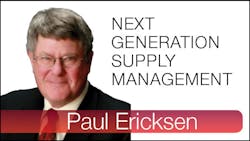The Extended Enterprise and Next Generation Supply Management
Even though I only met him once, one of my professional role models was Thomas Stallkamp who, along with Bob Eaton and Robert Lutz, made up the executive “triumvirate” responsible for Chrysler’s financial successes in the 1990s. Stallkamp was father of the extended enterprise approach to supply management. In fact, the term extended enterprise became so important to Chrysler that in 1999 they obtained a trademark for it, as follows:
Extended Enterprise: Extending business relationships by providing process management consultations and workshops to… suppliers and supplier tiers in order to reduce cycle time, to minimize system cost and to improve the quality of the goods or services provided by the suppliers.
Unfortunately, after the Chrysler-Daimler Benz “merger” Stallkamp and other top Chrysler executives got pushed aside by their German counterparts and many of the strategies they had installed—including extended enterprise supply management—were abandoned. Probably related to this, numerous business school case studies have been written on how Chrysler fared under Daimler Benz management and they all pretty much agree that things didn’t go well.
I personally got excited by Chrysler’s extended enterprise approach to supply management because it offered a new strategy for achieving business solutions that the more traditional, staid procurement practices were falling short on. I see Next Generation Supply Management as the natural evolution of what could have resulted had extended enterprise remained the basis of Chrysler’s supply chain strategy.
Next Generation Supply Management extends Stallkamp’s initial concept to the following: OEMs providing strategic suppliers the same level of technical support they would receive if they were internal factory departments.
Under this approach, strategic suppliers to original equipment manufacturers (OEMs) are no longer just given tactical performance goals and expected on their own accord to achieve them. Instead, OEMs collaborate with and assist them—as needed—in their continuous improvement efforts.
This may seem a bit benevolent. And when I first started implementing this derivative of Stallkamp’s extended enterprise approach, it did meet with resistance, for exactly that reason. I distinctly remember a discussion with a high-level executive where I worked who didn’t support the idea because, as he told me (and anyone else who would listen), “We pay our suppliers good money for their product. That should be enough.”
At the time I wasn’t at a level where I was in a position to argue with him. And, intellectually, he was right. But I was looking for a solution to a real world business problem in which suppliers weren’t hitting necessary performance goals on their own and the company I worked for was pretty much locked into some of them as sources. The key here is how to define the term strategic.
I’ve seen dozens if not hundreds, of attempts to define this term as it relates to suppliers and supply management strategies. The definition for “strategic supplier” in Next Generation Supply Management is non-traditional since—as is typical with most definitions—it does not relate to the impact of a supplier’s product on the buying decision of the end-use customer. Instead, it is defined simply as follows: Resourcing business from a strategic supplier exposes a purchaser to excessive cost or order fulfillment risk.
This can be due to any of number of business related reasons, including (but not limited to):
- There being few or no alternative supplier sources.
- Alternative sources may be aligned with the competition.
- The current supplier owns important intellectual property.
- The current supplier is too interwoven into your company—for instance, through product engineering—to replace.
So, as it always should, the decision to provide strategic suppliers as part of your extended enterprise comes down to a business decision, i.e., the costs/risks associated with changing sources vs. the cost of assisting current suppliers to improve performance. Strategic suppliers per the above definition are the types of suppliers that under Next Generation Supply Management are regarded as extensions of the OEM customer’s own factory—essentially outside departments—and treated as such.
In the end I was able to sell the extended enterprise idea internally and start-up a supplier development function at the divisional level, staffed mostly by industrial engineers. Later I was named supplier development process owner for the entire corporation. I’ve been retired from this company for almost a decade and it’s difficult for me to know whether the extended enterprise supplier development approach has lived on. I suspect, similar to the case of Stallkamp and Chrysler, that when the chief advocate of a strategy leaves, the strategy itself soon is altered or replaced. But also—similar to what occurred at Chrysler during its heyday—that same extended enterprise supplier development contributed greatly (and measurably) to improved financials for my employer.
In the next blog entry I’ll explore further Next Generation Supply Management supplier categories and the differences in how they should be managed.
About the Author
Paul Ericksen Blog
Paul's blog "Next Generation Supply Chain," has moved. You'll find his latest ideas and commentary on IndustryWeek's IdeaXchange.
You'll find more articles written by Paul at http://www.industryweek.com/blog/next-generation-supply-management.
Paul D. Ericksen has 38 years of experience in industry, primarily in supply management at two large original equipment manufacturers. At the second he was chief procurement officer. After this, Ericksen headed up a multi-year supply chain flexibility initiative funded by the U.S. Department of Defense. He presently is an executive level consultant in both manufacturing and supply chain, counting Fortune 100 companies among his clientele. His articles on supply management issues have been published in APICS, Industrial Engineering, Purchasing Today, Target and other periodicals.
